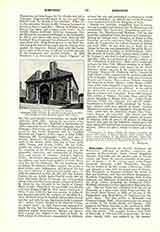

Rimouski, Diocese of (SANCTI GERMANI DE RIMOUSKI), suffragan of Quebec, comprises the counties of Bonaventure, Gaspe (except Magdalen Islands), Rimouski and the greater part of Temiscouata, and forms the eastern extremity of the province of Quebec. At the extreme point of the Gaspe peninsula (formerly called Honguedo), Jacques Cartier landed on his first voyage of discovery (1534) and planted a cross with the royal arms of France. The Souriquois or Micmacs occupied the shores of Baie des Chaleurs, and their successive missionaries, Recollets, Capuchins, Jesuits, amongst them Father Labrosse, and Spiritians (or priests of the seminary of the Holy Ghost), including the celebrated Pierre Maillard, ministered to that region of the Rimouski diocese. The first Mass was celebrated near the city of Rimouski, at a place since called Pointe-au-Pere, by the Jesuit Henri Nouvel, in 1663, on his way to the Papinachois and Montagnais of Tadoussac, on the north shore. The first settler at Rimouski was Germain Lepage (1696), whose patronymic was chosen as titular of the future parish and diocese. The seigniory had been conceded to his son Rene in 1688. The latest statistics give 120 churches and chapels, with 148 priests. Two wooden churches were built at Rimouski, in 1712 and 1787 respectively; the first stone church, 1824, was replaced by the present cathedral in 1854. Before the creation of the see, Rimouski was successively visited by Bishops Hubert (1791), Denaut (1798), Plessis (1806-14-22), Panet (1810-26), Signay (1833-38-43), Turgeon (1849), and Baillargeon (1855-60-65). The see was created and its first titular nominated on January 15, 1867, and acquired civil incorporation ipso facto the same day, according to the law of the country.
The first bishop, Jean-Pierre-Francois Laforce-Langevin, was b. at Quebec, September 22, 1821, and ordained on September 12, 1844. As director of the Quebec seminary he was one of the joint founders of Laval University (1852). He successively filled the offices of pastor to the parishes of Ste Claire and Beauport, and of principal of Laval Normal School. He was consecrated May 1, 1867, resigned 1891, and died 1892. He completed the organization of a classical college previously founded by the Abbes C. Tanguay and G. Potvin and adopted it as the seminary of the diocese. He introduced the Sisters of the Congregation of Notre-Dame (Montreal) and sanctioned the foundation (1879) of the Sisters of the Most Holy Rosary, a flourishing institute largely due to the zeal of Vicar-General Langevin, his brother. Bishop Langevin established the cathedral chapter in 1878.
The second bishop, still in office, Andre-Albert Blais, b. at St-Vallier, P. Q., 1842, studied at the college of Ste Anne de la Pocatiere, graduated in Rome Doctor of Canon Law, and taught the same branch at Laval University. He was consecrated bishop May 18, 1890, and took possession of the see in 1891. Bishop Blais created many new parishes in the diocese, and founded a normal school under the management of the Ursulines. The clergy, exclusively French-Canadian, study classics and philosophy at the diocesan seminary, and theology principally at Laval University, in some cases at the Propaganda, Rome. (For parochial system, incorporation of religious institutions, etc., see Canada. and Province of Quebec.) There are no cities besides Rimouski, but all the larger rural parishes have fine churches and convent-schools; the only domestic mission is that of the Micmacs at Ristigouche, under the care of the Capuchins. Besides a. Priests’ Aid Society, there are several benevolent and mutual aid societies for the laity. The religious orders of men are the Capuchins, Eudists, and Brothers of the Cross of Jesus; those of women are the Ursulines, Sisters of Charity, of the Good Shepherd (teaching), of the Holy Rosary, of the Holy Family, and the Daughters of Jesus. Retreats for the clergy are given each year; conferences to discuss theological cases take place every three months. Nearly all the secular clergy (110 out of 137) belong to the Eucharistic League. Out of a total Catholic population of 118,740, only 3695 are not French Canadians. The Indians number 610. The Protestant element amounts to 8798. There is no friction between these different elements and no difficult racial problem to solve, the parishes containing an English-speaking element as well as the Micmacs being instructed in their native tongues.
LIONEL LINDSAY

